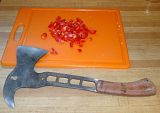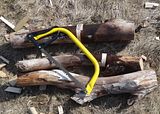
- North 49 Camp Axe
- Fiskar's Sportsman
- Gransfors Bruks Wildlife Hatchet
- Black King
- Japanese Camp Axe
- cKc Hatchet
This review consists of :

|
Knives :
This review consists of : |
The cKc hatchet is an interesting offering by Kyley Harris of cKc knives which was intended to compete as a wood processing tool alongside the high end traditional wood hafted hatchets and offer higher utility as a cutting tool due to the flat stock which produces a much thinner bit.
Harris has quite a number of videos on YouTube on his channel starting from the development of the hatchet, the grind, light use, kitchen use and an fairly comprehensive comparison against a Wetterlings in the video on the right which is one of the better of the traditional wood hafted hatchets.
Performance from a hatchet depends on user skill, strength and wood type so it isn't trivial to generalize but the video on the right and the other video's on Kyley's channel paint a picture of a very decent hatchet.
Basic specifications :
Some specifics on the grind :
Initial impressions :
and cutting ability :
 Using the cKc medium hatchet on some demo work it tended not to be overly
effective on taking apart wood as noted in the picture in the right.
Basically :
Using the cKc medium hatchet on some demo work it tended not to be overly
effective on taking apart wood as noted in the picture in the right.
Basically :
 After attending
a forestry trade show and getting some seedlings
the cKc hatchet was used to make a small hole to
plant the root bulb
The spike easily works in the ground, doesn't matter if
it is rocky or not. The spike is very robust and
thus there is no issue in
wrenching the hatchet to the side to open up the hole
and allow the bulb to be planted easily.
Now of course this can be done easily with a
knife, just stab it in and do the same, but it will pretty heavily blunt
the top and leading edge.
After attending
a forestry trade show and getting some seedlings
the cKc hatchet was used to make a small hole to
plant the root bulb
The spike easily works in the ground, doesn't matter if
it is rocky or not. The spike is very robust and
thus there is no issue in
wrenching the hatchet to the side to open up the hole
and allow the bulb to be planted easily.
Now of course this can be done easily with a
knife, just stab it in and do the same, but it will pretty heavily blunt
the top and leading edge.
The hatchet of course is more than just the spike and it readily splits a piece of strapping, points it and then easily pounds it into the ground. The versatility really shines in such work as it works as a digging spike, hammer, axe and carving knife. Of course for transplanting larger trees then actual gardening tools would want to be used to make the much larger holes for the bigger root bulbs, but again the range of work for which the cKc hatchet is able to work well has shown to be quite large.
 Now of course the cKc medium hatchet is a lot more awkward than an actual
kitchen knife simply due to size and weight but it
could steel peel and make the horizontal
cuts necessary for fine dices on onions and for low volume work there really
was no significant issue. In regards to
direct force comparisons slicing the small onions (3" diameter) :
Now of course the cKc medium hatchet is a lot more awkward than an actual
kitchen knife simply due to size and weight but it
could steel peel and make the horizontal
cuts necessary for fine dices on onions and for low volume work there really
was no significant issue. In regards to
direct force comparisons slicing the small onions (3" diameter) :
 Something more interesting came up cutting some sweet peppers as the hatchet
was easier to use to make the cuts. The Everyday Essentials required more
force to complete the cuts through the exterior skin (cutting skin side down).
At first it was thought that it may be because the hatchet was sharper as it
was recently sharpened and the Everyday Essentials was about five weeks being
used as the main and only knife in the kitchen with the initial edge.
Something more interesting came up cutting some sweet peppers as the hatchet
was easier to use to make the cuts. The Everyday Essentials required more
force to complete the cuts through the exterior skin (cutting skin side down).
At first it was thought that it may be because the hatchet was sharper as it
was recently sharpened and the Everyday Essentials was about five weeks being
used as the main and only knife in the kitchen with the initial edge.
However looking at the mechanics in a bit more detail, the cKc hatchet has a full edge sweep (as does every axe aside from dedicated carpentry axes which can be square edges) and so doing draw cuts only a small section of the edge was hitting the cutting board and thus the pressure was very high. In comparison the edge on the Everyday Essentials is very flat, as it has very little belly and so the pressure was low unless the force used was very high.
 As a basic check on carving/shaping the cKc medium hatchet was used to take a
piece of deadfall spruce and make a few beetles or small clubs. These are
useful for splitting wood or any other time you want a hammer but do not want
to use steel. The main concern here was that the birch was a bit rotted but
since there was a lot of it at least one decent mallet should be able to be
made. To start the process the small stick was cut to a few lengths with a
small buck saw. Of course the hatchet could easily buck the wood but it is
wasteful as you lose basically the thickness of the wood in length each time
you have to make a cut.
As a basic check on carving/shaping the cKc medium hatchet was used to take a
piece of deadfall spruce and make a few beetles or small clubs. These are
useful for splitting wood or any other time you want a hammer but do not want
to use steel. The main concern here was that the birch was a bit rotted but
since there was a lot of it at least one decent mallet should be able to be
made. To start the process the small stick was cut to a few lengths with a
small buck saw. Of course the hatchet could easily buck the wood but it is
wasteful as you lose basically the thickness of the wood in length each time
you have to make a cut.
The main concerns starting out was :
 Working through the sticks, there was that much rot that only one really
decent mallet could be made with one other small one only useful for light
work and one pretty rough shaped one. In general throughout the cutting :
Working through the sticks, there was that much rot that only one really
decent mallet could be made with one other small one only useful for light
work and one pretty rough shaped one. In general throughout the cutting :
The Fiskar's Sportman was used as well and while it is much lighter and has a lower fatigue rate on the precision chopping, over all for this small volume of work this wasn't a factor and the other higher abilities of the cKc medium hatchet easily made it the superior choice.
 Ergonomics : there are a few concerns with comfort in use.
The most obvious being a high grip around the haft to allow maximum force to
be used in the cut when carving. The problems are :
Ergonomics : there are a few concerns with comfort in use.
The most obvious being a high grip around the haft to allow maximum force to
be used in the cut when carving. The problems are :
 Shifting the grip down under the hump removes the main contact point but still
leaves the grip around a fairly thin haft. All of the carving and light
cutting work was done with this grip and it was not problematic enough to
cause anything aside from minor discomfort but it does give a pretty
significant leverage disadvantage.
Shifting the grip down under the hump removes the main contact point but still
leaves the grip around a fairly thin haft. All of the carving and light
cutting work was done with this grip and it was not problematic enough to
cause anything aside from minor discomfort but it does give a pretty
significant leverage disadvantage.
In some detail using a a piece of pine (0.5"x1" ) and making 2" points with heavy force (75-100 lbs). The following were the required number of slices :
Note the Fiskar's was reground as noted previously and with the regrind it is close to the Mora, respectful performance considering it is an axe. The cKc hatchet actually has a thinner edge profile than the Fiskar's and even the Mora but as you are cutting so far in front and out past your grip you have a severe leverage and torque disadvantage and thus it can not compete.
Security : the handle security was a high point. It was easily in a class about the Fiskar's which is useless to the point of being dangerous when wet. A rough sanding on the micarta left it with a high tack on the grip and that combined with the shallow curvature (high width to thickness ratio) made it very stable in handle. It never wanted to roll or twist and was easily usable even when wet.
Durability : the durability is very high as the grip is steel and micarta. Outside of extreme impacts of conditions such as it being shot or exposed to strong acids, it is pretty much invulnerable.
Miscellaneous :
 As a basic check on edge retention, through
1000 slices through pine :
As a basic check on edge retention, through
1000 slices through pine :
Without strict measurement on thread or similar it would be difficult to even know that it was used.
This of course would be expected and it not an indication of high performance as any tempered steel which could not do that is either not hardened at all or has very serious problems with the hardening. However it is a decent first place to start and also gives a decent idea of cutting ability and comfort, both of which are solid with this tool.
As a harder check on the edge, the hatchet was used to cut up some fresh beef bones. Now all bones vary in density, even in the same type of animal so variance can be expected. The bone cutting in the video was also done so as to minimize stress on the blade using the following conditions :
Overview :
Maker Webpage : cKc Knives , and YT Homepage.
Comments can be emailed to cKc Medium Hatchet : Intro
and/or the YouTube Playlist.
Most of the pictures in the above are in the PhotoBucket album.
| Last updated : | Sun, 22 Apr 2012 21:47:33 Newfoundland Daylight Time |
| Originally written: | Tue, 27 Mar 2012 21:49:55 Newfoundland Daylight Time |